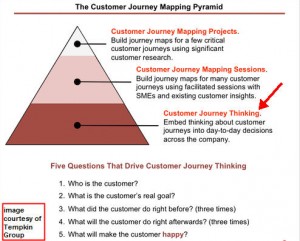You may recall attending, at our 2012 Public Services Retreat, an afternoon workshop on Customer Journey Mapping. We divided up into teams and tackled two specific journeys that our community members regularly take as they navigate our library environment. Half of us worked on the journey faculty travel to put materials on e-reserves. The other half worked on the journey traveled to retrieve a scholarly article. Our workshop facilitator was James Moustafellos, a faculty member is the Fox School MIS Department. For many of us it was an eye-opening experience to see that as our users took these journeys they encountered multiple pain points. With respect to e-reserves, migrating to ARES has eliminated many of these pain points as it is now much easier for faculty to put items on e-reserve and for students to locate these items.
Though we often lack the time to get together for these types of workshops where we can spend a few hours mapping the journeys and analyzing them (and don’t forget we all needed to spend a few hours gathering data and artifacts in advance of the workshop), there may be something each of us can do on a regular and individual basis to adopt a customer journey mindset as we go about our work. It involves a process of asking yourself five questions, while you attend to your day-to-day activities, about our community members’ library journey. According to a blog post at Customer Experience Matters, it may be adequate to integrate what they call “Customer Journey Thinking” into your practice. Here is how they describe it:
Embed thinking about customer journeys into day-to-day decisions across the organization. Employees actively consider why customers are interacting with the organization and think about how those interactions fit within the customers’ broader set of objectives and activities. The goal: Encourage every employee to think about customers’ journeys.
It is the first of three levels that make up the Customer Journey Mapping Pyramid. It involves asking yourself five questions related to your transactions and interactions with community members. These questions are included in the Pyramid figure below:
One way to think of it is to become a reflective thinker about your interactions with students, faculty, alumni, guests and others. What happened? Could it have gone better? What will I do to improve next time? The five questions can help take you through the reflection process.
Who is the community member? Start by recognizing that different segments of our community have different needs. Consider who that person is before thinking about their specific journey.
What is the community member’s real goal? Why was the person using the library and what brought them to you. To understand how that community member views an interaction and what’s shaping their expectations, you need to think about what they are really trying to accomplish?
What did the customer do right before? The patron may be contacting you now, but it is probably part of a longer journey. So you need to think about where they’ve been prior to the interaction in order to understand how they will respond to an interaction with library.
What will the community member do right afterwards? When patrons interact with us it’s almost never the last step on their journey. So we need to think about what they will do next to understand how to best help them.
What will make the community member happy? Rather than just aiming to satisfy customers’ basic needs, think about what it will take to provide each person you encounter with the most positive experience–given what we know about their real goals and their entire journeys.
Taking time to think through interactions with community members – being reflective about the exchange whether brief or time consuming – may help each of us to better observe where the pain points in their journey occur. We can then work together to eliminate those pain points, improve that journey and help build a better overall library experience.
If you think there may be value in doing more in depth customer journey mapping projects, please let me know.

